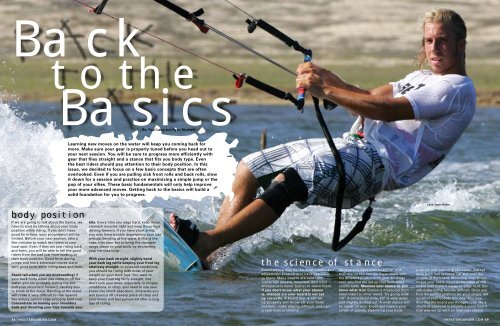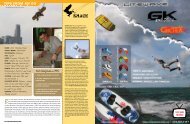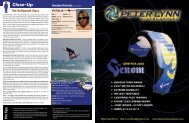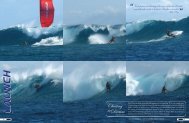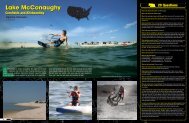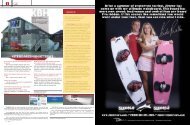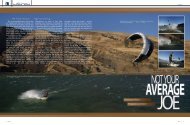body position the science of stance - Kitesurfarea.com
body position the science of stance - Kitesurfarea.com
body position the science of stance - Kitesurfarea.com
Create successful ePaper yourself
Turn your PDF publications into a flip-book with our unique Google optimized e-Paper software.
Back to <strong>the</strong><br />
Basics<br />
By: Paul Lang and Ryan Riccitelli<br />
Learning new moves on <strong>the</strong> water will keep you <strong>com</strong>ing back for<br />
more. Make sure your gear is properly tuned before you head out to<br />
your next session. You will be sure to progress more efficiently with<br />
gear that flies straight and a <strong>stance</strong> that fits you <strong>body</strong> type. Even<br />
<strong>the</strong> best riders should pay attention to <strong>the</strong>ir <strong>body</strong> <strong>position</strong>. In this<br />
issue, we decided to focus on a few basic concepts that are <strong>of</strong>ten<br />
overlooked. Even if you are pulling sick front rolls and back rolls, slow<br />
it down for a session and practice on maximizing a simple jump or <strong>the</strong><br />
pop <strong>of</strong> your ollies. These basic fundamentals will only help improve<br />
your more advanced moves. Getting back to <strong>the</strong> basics will build a<br />
solid foundation for you to progress.<br />
Lens: Gavin Butler<br />
<strong>body</strong> <strong>position</strong><br />
If we are going to talk about <strong>the</strong> basics, we<br />
have to start by talking about your <strong>body</strong><br />
<strong>position</strong> while riding. If you don’t have<br />
good form here, your progression will be<br />
limited. Before your next session, take a<br />
few minutes to watch <strong>the</strong> riders at your<br />
local spot. Even if <strong>the</strong>y are just riding back<br />
and forth, you will be able to tell <strong>the</strong> good<br />
riders from <strong>the</strong> bad just from looking at<br />
<strong>the</strong>ir <strong>body</strong> <strong>position</strong>. Good form during<br />
jumps and more advanced moves starts<br />
with good form while riding back and forth.<br />
Stand tall when you are kiteboarding! If<br />
your back hurts when you <strong>com</strong>e in <strong>of</strong>f <strong>the</strong><br />
water, you are probably letting <strong>the</strong> kite<br />
pull your shoulders forward, causing you<br />
to break at <strong>the</strong> waist. Bending at <strong>the</strong> waist<br />
will make it very difficult to ride upwind.<br />
You simply cannot edge properly bent over.<br />
Concentrate on leaning your shoulders<br />
back and thrusting your hips towards your<br />
kite. Every time you edge hard, keep those<br />
stomach muscles tight and keep those hips<br />
driving forward. If you have short arms,<br />
you may have trouble depowering your kite<br />
without bending at <strong>the</strong> waist. If this is <strong>the</strong><br />
case, trim your bar to bring <strong>the</strong> depower<br />
range closer to your <strong>body</strong> by shortening<br />
your harness loop.<br />
With your back straight, slightly bend<br />
your back leg while keeping your front leg<br />
relatively straight. In powered conditions,<br />
you should be riding with most <strong>of</strong> your<br />
weight on your back foot. You want to<br />
keep your front leg fairly straight, but<br />
don’t lock your knee, especially in choppy<br />
conditions. In chop, you need to use your<br />
knees like shock absorbers, o<strong>the</strong>rwise you<br />
will bounce <strong>of</strong>f <strong>of</strong> every piece <strong>of</strong> chop and<br />
your knees will feel pulverized after a long<br />
day <strong>of</strong> riding.<br />
<strong>the</strong> <strong>science</strong> <strong>of</strong> <strong>stance</strong><br />
Board <strong>stance</strong> may be <strong>the</strong> most overlooked<br />
adjustment kiteboarders have available<br />
to <strong>the</strong>m. Many boards are sold with<br />
footstraps already mounted, and most<br />
kiteboarders never bo<strong>the</strong>r to move <strong>the</strong>m.<br />
If you don’t know what your <strong>stance</strong><br />
is, chances are your board is not set<br />
up correctly. A board that is not set<br />
up properly will throw <strong>of</strong>f your <strong>body</strong><br />
<strong>position</strong>, make edging difficult, and can<br />
create knee problems.<br />
Most people have <strong>the</strong>ir board set with<br />
<strong>the</strong>ir <strong>stance</strong> too narrow. Experiment with<br />
<strong>the</strong> different <strong>position</strong>s for your bindings<br />
until you find <strong>the</strong> set-up that feels most<br />
<strong>com</strong>fortable. Measure your <strong>stance</strong> so you<br />
know what it is! Stance is measured from<br />
inner insert to inner insert. Try going wide<br />
(18” is considered wide, 20” is very wide)<br />
and slightly ducked out. A wide <strong>stance</strong> will<br />
be easier on your knees and lowers your<br />
center <strong>of</strong> gravity, stabilizing your <strong>body</strong><br />
<strong>position</strong> and making grabs easier. Always<br />
keep both feet symmetrical and over <strong>the</strong><br />
middle <strong>of</strong> <strong>the</strong> board. Mounting your straps<br />
to put your heels closer to <strong>the</strong> edge <strong>of</strong> <strong>the</strong><br />
board may make it easier to edge hard, but<br />
will make riding toeside difficult. Once you<br />
find <strong>the</strong> perfect <strong>position</strong> for your straps, set<br />
up all <strong>of</strong> your boards this way. You may<br />
find that <strong>the</strong> board you thought rode like a<br />
chunk <strong>of</strong> plywood is actually a great board<br />
that was set up with an improper <strong>stance</strong>.<br />
58 <strong>the</strong>kiteboarder.<strong>com</strong> <strong>the</strong>kiteboarder.<strong>com</strong> 59
tune your kite! please!<br />
We’ve talked about it before, but we still see a lot <strong>of</strong> people riding<br />
gear that is not tuned properly. Tuning your kite is something that<br />
every level <strong>of</strong> kiteboarder needs to know how to do, especially<br />
beginners. A kite that is improperly trimmed will not fly correctly<br />
and may be prone to falling out <strong>of</strong> <strong>the</strong> sky. Take <strong>the</strong> time to set<br />
your gear up right, so that you can eliminate gear problems as <strong>the</strong><br />
cause <strong>of</strong> your problems on <strong>the</strong> water.<br />
1. Your first step is to hook all four or five lines to a solid object,<br />
like a tree or <strong>the</strong> bumper <strong>of</strong> your car. Pull <strong>the</strong> lines tight and adjust<br />
your lines, so <strong>the</strong>y are all even.<br />
2. Fly your kite with all lines even. While hooked in, put <strong>the</strong> kite<br />
overhead and let go <strong>of</strong> <strong>the</strong> bar. If <strong>the</strong> kite has a tendency to always<br />
turn one way at <strong>the</strong> top <strong>of</strong> <strong>the</strong> window, your steering lines are still<br />
<strong>of</strong>f. Fix this by shortening <strong>the</strong> line opposite <strong>the</strong> way <strong>the</strong> kite turns<br />
(if <strong>the</strong> kite drifts left, shorten your right steering line). You can<br />
easily do this by tying a knot in your leader line.<br />
3. Once steering problems are resolved, you can move on to front<br />
line-back line trim. An under-trimmed kite (front lines too short)<br />
will respond slowly and produce little power. An over-trimmed kite<br />
(front lines too long), will be unstable and have a tendency to stall<br />
backwards, especially at <strong>the</strong> edge <strong>of</strong> <strong>the</strong> window. Most kites, but<br />
not all, will be properly trimmed with all lines even.<br />
4. A properly tuned C-kite will have both wingtips parallel, and a<br />
tuned bow kite will sit on <strong>the</strong> edge <strong>of</strong> <strong>the</strong> window without stalling<br />
backwards. To find this proper trim, power up your kite (leng<strong>the</strong>n<br />
your front lines) until you ei<strong>the</strong>r see <strong>the</strong> wingtips flair out (C-kite) or<br />
<strong>the</strong> kite begins to want to move backwards (bow kite). Then depower<br />
your kite (shorten your front lines) until it be<strong>com</strong>es stable again.<br />
Riding lit!<br />
You should never want to ride overpowered by choice, but <strong>the</strong>re<br />
are many times when you will find yourself flying more kite than is<br />
ideal. With high depower kites, it is possible to ride with way more<br />
kite than is necessary, but this is a bad habit to fall into. Wea<strong>the</strong>r<br />
conditions change all <strong>the</strong> time, so you will end up overpowered<br />
sooner or later even if you choose <strong>the</strong> perfect kite every time you<br />
rig. Here’s how you should deal with it:<br />
The key to riding overpowered is speed control. If you can keep<br />
your speed under control, you can ride through <strong>the</strong> largest gusts<br />
with no problem. When you are overpowered, you actually want to<br />
ride slower than you would if you were perfectly powered. Riding<br />
slowly will keep <strong>the</strong> kite near <strong>the</strong> edge <strong>of</strong> <strong>the</strong> window, where <strong>the</strong><br />
kite has less power. Riding fast causes your kite to drift back in <strong>the</strong><br />
window, which creates more power and causes you to accelerate<br />
faster and faster until you explode in a ball <strong>of</strong> spray. Avoid this<br />
situation by keeping your speed under control. If you find yourself<br />
picking up so much speed that you cannot slow down by edging,<br />
carve downwind sharply without moving <strong>the</strong> kite. This must be<br />
done quickly and with confidence. Carving downwind for a moment<br />
will cause <strong>the</strong> kite to shoot forward in <strong>the</strong> window, reducing power.<br />
The first few times you do this, you will crash, but once you dial it<br />
in, it is a really functional way to dump extra speed and power. Back<br />
in <strong>the</strong> day before kites with super range, this was really <strong>the</strong> only<br />
way to depower, and good riders had to be very <strong>com</strong>fortable at high<br />
speeds to keep control <strong>of</strong> <strong>the</strong> kite.<br />
The whole process shouldn’t take any more than 30 minutes, so<br />
be productive on <strong>the</strong> next light wind day and spend a little time<br />
making your gear fly right. Every kite is a little different, and<br />
some kites are more difficult to tune than o<strong>the</strong>rs. Take <strong>the</strong> time<br />
to set up your kite properly. Don’t dismiss kite trim as being too<br />
difficult or unimportant! Dialing you kite is not just for techies,<br />
it’s for everyone. If you are having trouble dialing in your kite,<br />
talk to o<strong>the</strong>r kiters, <strong>the</strong> shop that sold you <strong>the</strong> kite, or your kite<br />
manufacturer.<br />
When riding overpowered, it’s important to have good edging<br />
skills, and this starts by having good <strong>body</strong> <strong>position</strong>. No matter how<br />
overpowered you are, don’t give in to <strong>the</strong> urge to bend at <strong>the</strong> waist.<br />
Keep your shoulders back, remembering to drive your hips towards<br />
<strong>the</strong> kite while focusing your weight through your back heel. Don’t<br />
forget to depower <strong>the</strong> kite using your depower strap, so you do not<br />
have to stretch your arms to get your kite’s full depower.<br />
How to Slog<br />
It would be great to have <strong>the</strong> right size kite<br />
for every condition, but <strong>the</strong> reality is that<br />
most <strong>of</strong> us only have two or three kites,<br />
leaving us wishing for more power on <strong>the</strong><br />
lighter days. In some light wind spots, like<br />
San Diego, riding underpowered is a way<br />
<strong>of</strong> life. Riders in San Diego are able to have<br />
fun on days most o<strong>the</strong>rs would write <strong>of</strong>f as<br />
being unridable. There is a definite art to<br />
riding underpowered, and a little practice<br />
will expand your definition <strong>of</strong> conditions you<br />
think <strong>of</strong> as fun.<br />
Technique can go a long way to squeezing<br />
<strong>the</strong> most out <strong>of</strong> underpowered conditions,<br />
but your gear is <strong>the</strong> biggest factor in<br />
determining your low-end limit. Ride your<br />
largest kite with your biggest bar and normal<br />
length lines. Longer lines can help you kite in<br />
very underpowered conditions, but you start<br />
taking up way more than your fair amount<br />
<strong>of</strong> space when your lines get over 30 meters.<br />
Your board is a huge factor in determining<br />
your bottom end. A larger board with little<br />
rocker or a surfboard can keep you going<br />
when everyone else gives up.<br />
The big secret to kiting in light wind is in your<br />
feet. You have to shift your weight forward<br />
in <strong>the</strong> lulls and back in <strong>the</strong> gusts. If you are<br />
riding a surfboard with straps, get your feet<br />
out <strong>of</strong> <strong>the</strong> straps and move your feet forward<br />
on <strong>the</strong> board. In light wind, you can’t try to<br />
go upwind <strong>the</strong> whole time you are riding.<br />
Creating speed is more important than<br />
trying to go upwind. In <strong>the</strong> lulls, flatten <strong>the</strong><br />
board and let yourself go downwind to build<br />
speed. As your speed increases, you can<br />
start weighting your back foot and edging,<br />
but do it gently. If you edge aggressively,<br />
you will simply stop and sink. You can also<br />
pump your board to keep speed up and work<br />
your way upwind. Watch any surfer in mushy<br />
waves and you will see <strong>the</strong>m pump <strong>the</strong>ir<br />
board to keep speed up to make a section.<br />
When underpowered, move your hands<br />
out to <strong>the</strong> ends <strong>of</strong> your bar and move <strong>the</strong><br />
kite up and down as aggressively as you<br />
can. Remember that kite speed is just as<br />
important as board speed. Don’t just sheet<br />
your kite in all <strong>the</strong> way in and edge your<br />
board. You’ve got to finesse it. To get <strong>the</strong><br />
most out <strong>of</strong> your power strokes with <strong>the</strong><br />
kite, edge slightly harder when <strong>the</strong> kite is<br />
diving down and <strong>the</strong>n ease up and flatten<br />
<strong>the</strong> board while <strong>the</strong> kite is on <strong>the</strong> way up.<br />
Kiting underpowered is frustrating and tiring.<br />
It usually helps to occasionally blurt out<br />
expletives. If nothing else, kiting in bottom<br />
<strong>of</strong> <strong>the</strong> barrel conditions will make you<br />
appreciate <strong>the</strong> good days even more.<br />
Lens: Ryan Riccitelli<br />
60 <strong>the</strong>kiteboarder.<strong>com</strong> <strong>the</strong>kiteboarder.<strong>com</strong> 61
1<br />
2<br />
3<br />
Try this:<br />
basics Moves for<br />
your next session<br />
Ollie 180<br />
The ollie 180 is an easy move to learn and forms an important base from which<br />
to build more advanced moves. As we have said before, you’ve got learn to walk<br />
before you can run.<br />
1. Start by riding with good board speed and your kite 45º to 60º above <strong>the</strong> water.<br />
2. Hold <strong>the</strong> kite steady as you pop <strong>the</strong> board <strong>of</strong>f <strong>the</strong> water by standing tall and<br />
pushing <strong>of</strong>f <strong>of</strong> your back foot.<br />
3-4. Grab <strong>the</strong> board for style. To simplify learning this move, ignore <strong>the</strong> grab until<br />
you can do a 180 without <strong>the</strong> grab.<br />
5-6. Rotate through <strong>the</strong> 180 by turning your shoulders and hips – your legs will<br />
follow if you <strong>com</strong>mit to <strong>the</strong> move.<br />
7. Spot your landing and stomp down with your back foot (this was your front foot<br />
at <strong>the</strong> beginning <strong>of</strong> <strong>the</strong> move).<br />
8-9. Bend your knees to absorb <strong>the</strong> landing and ride away.<br />
1<br />
2<br />
3<br />
4<br />
4<br />
6<br />
5<br />
5<br />
6<br />
Lens: Gavin Butler<br />
7<br />
jump with control<br />
A simple jump with lots <strong>of</strong> hangtime may not be <strong>the</strong> most technical trick, but few<br />
things beat <strong>the</strong> sensation <strong>of</strong> flying through <strong>the</strong> air. If your jumps are not going right,<br />
stop hucking yourself into <strong>the</strong> air and hoping for <strong>the</strong> best. Take <strong>the</strong> time to learn <strong>the</strong><br />
proper technique, step by step.<br />
Lens: Ryan Riccitelli<br />
7<br />
8<br />
9<br />
1. Start by riding with good board speed with your kite 60º above <strong>the</strong> water.<br />
2. Set up for your jump by pulling with your back hand to send <strong>the</strong> kite up and away<br />
from your riding direction. You must move <strong>the</strong> kite quickly, but not too far. As you<br />
send <strong>the</strong> kite back, you have to stop <strong>the</strong> kite’s movement just over your back shoulder.<br />
If you whip <strong>the</strong> kite too hard or too far behind you, it will pull you <strong>of</strong>f your edge and<br />
you will not get very much elevation.<br />
3. As <strong>the</strong> kite crosses overhead, edge upwind hard, sheet in, and pop <strong>the</strong> board <strong>of</strong>f<br />
<strong>the</strong> water. The timing <strong>of</strong> when you edge and pop is critical to get <strong>the</strong> most out <strong>of</strong> your<br />
jumps. The exact timing varies with equipment and conditions and takes a lot <strong>of</strong> trial<br />
and error to get right.<br />
4-6. As you near <strong>the</strong> apex <strong>of</strong> your jump, start pulling with your forward hand to bring<br />
<strong>the</strong> kite back over your head. The exact timing <strong>of</strong> this step takes awhile to perfect and<br />
depends on your gear, <strong>the</strong> conditions, and <strong>the</strong> height <strong>of</strong> your jump.<br />
7. Fly <strong>the</strong> kite over your head to float gently back down.<br />
8. As you near <strong>the</strong> water, pull hard with your forward hand to dive <strong>the</strong> kite so that you<br />
land with speed.<br />
9. Bend your knees to absorb <strong>the</strong> landing and ride away.<br />
8<br />
9<br />
62 <strong>the</strong>kiteboarder.<strong>com</strong><br />
<strong>the</strong>kiteboarder.<strong>com</strong> 63
PRODUCT WATCH<br />
CAUTION Heckler<br />
DAKINE Boost II Deckpad<br />
This fast flying, stable freestyle kite<br />
delivers instant response in <strong>the</strong> turns<br />
and a huge depower range for gusty<br />
winds. Thanks to <strong>the</strong> tapered leading<br />
edge and balance <strong>of</strong> <strong>the</strong> C5 5th line bar<br />
system, <strong>the</strong> Heckler is great for wave<br />
riding and new school unhooked moves.<br />
Smooth power delivery through turns<br />
is <strong>the</strong> Heckler’s specialty. Caution’s<br />
proven, tough construction make this<br />
kite a great choice for freestyle or<br />
wave riders needing a responsive, tight<br />
pivoting, lightweight kite without giving<br />
up durability.<br />
Sizes: 5, 7, 9, 12, 15m<br />
MSRP: starting at $950.00 <strong>com</strong>plete<br />
cautionkites.<strong>com</strong><br />
The 2007 Boost II pads feature a revolutionary unidirectional<br />
foot-holding traction pattern. The pad is<br />
angled for getting in <strong>the</strong> strap, with vertical walls<br />
to keep your foot from accidentally<br />
slipping out. For ultimate <strong>com</strong>fort,<br />
<strong>the</strong> pad is constructed <strong>of</strong> specially<br />
formulated molded shock<br />
absorbing foam with built in arch<br />
support. There are two mounting options<br />
available, peel and stick adhesive backing or<br />
mounting plates, for easy installation.<br />
Sizes: One size fits all<br />
MSRP: $24.00 per pair, $30.00 with mounting plate<br />
dakine.<strong>com</strong><br />
CAUTION Hustler<br />
EH KITEBOARDING EH Beast<br />
AIRUSH Halo<br />
In its second year, Airush’s dedicated<br />
bow design has seen an intense<br />
year <strong>of</strong> refinement. Working within<br />
<strong>the</strong> parameters <strong>of</strong> <strong>the</strong> original bow<br />
concept, <strong>the</strong>y have focused on<br />
increased stability in <strong>the</strong> smaller<br />
sizes and improved steering and<br />
responsiveness in <strong>the</strong> bigger sizes.<br />
Sizes: 7, 10, 12, 14m<br />
MSRP: starting at $1078.00 <strong>com</strong>plete<br />
airushkiteboarding.<strong>com</strong><br />
BEST Best Bar 07<br />
Best’s all carbon 07 bar features<br />
a new dual depower rope with an<br />
adjustable stopper, Stiffy Disc and<br />
Straight Plate for unhooking, mouse<br />
ear swivel for twist free loops and<br />
spins, and a new ergonomic grip.<br />
Total user adjustability, multiple rear<br />
line re-rides and center line bypass<br />
leash options <strong>of</strong>fer total flexibility in<br />
safety function and activation.<br />
Sizes: 45cm, 55cm<br />
MSRP: Bar w/23m lines $294.00, 25m lines $299.00<br />
bestkiteboarding.<strong>com</strong><br />
BEST Drive Series 07<br />
Developed using many high tech manufacturing<br />
procedures and tuned and tested by Shannon<br />
Best, <strong>the</strong> 07 Drive series delivers maximum<br />
performance, reliability and enjoyment no matter<br />
what conditions you ride in. The series consist<br />
<strong>of</strong> three regular drives and two limited edition<br />
versions. Features include a CNC Airex foam<br />
core, a single concave bottom, controlled flex<br />
zones, and ABS bottom and top sheets.<br />
Sizes:121 x 37.1,125 x 38.6, & 131 x 39.4cm<br />
MSRP: $529.00 board only; $620.00 <strong>com</strong>plete<br />
bestkiteboarding.<strong>com</strong><br />
CABRINHA Custom<br />
The Custom model retains its dedicated wakestyle/<br />
freeride design elements. It is <strong>the</strong> board <strong>of</strong> choice for<br />
riders like Andre Phillip looking for performance and<br />
excellent pop. Its wider plan-form and progressive<br />
rocker give <strong>the</strong> board a solid feel for wakestyle riding.<br />
The entirely new construction technique features<br />
an ABS sidewall, a PVC core, and mixed weight<br />
quadraxial glass to keep <strong>the</strong> durability high and <strong>the</strong><br />
weights low. The new Custom <strong>com</strong>es <strong>com</strong>plete<br />
with all new multi-density footpads, wide-<strong>body</strong><br />
adjustable straps, a handle, and 4 x 2” G10 fins.<br />
Sizes: 128x38, 133x39, & 138x42 cm<br />
MSRP: $604.00 board only; $739.00 <strong>com</strong>plete<br />
cabrinhakites.<strong>com</strong><br />
By: Gary Martin<br />
The 2007 Hustler is a wide-style twin<br />
tip that was shaped by <strong>the</strong> legendary<br />
Jimmy Lewis. A quick to plane, easy-toride<br />
shape was at <strong>the</strong> top <strong>of</strong> <strong>the</strong> criteria<br />
when creating <strong>the</strong>se ultra-smooth,<br />
upwind machines. The 145 is <strong>the</strong> ideal<br />
novice and heavy guy board with its<br />
wide outline, deep concave bottom<br />
and moderate length. New features<br />
include very <strong>com</strong>fortable and size<br />
ac<strong>com</strong>modating adjustable footstraps,<br />
stainless steel 1/4” 20 inserts, <strong>com</strong>fy<br />
ergonomic footpads, new lower pr<strong>of</strong>ile<br />
carbon grab handle, and indestructible<br />
hyper foil G10 fins.<br />
Sizes: 135 x 46.35cm, 145 x 46cm<br />
MSRP: $610.00 <strong>com</strong>plete<br />
cautionkites.<strong>com</strong><br />
GLOBE KITES GK 07 Sonic<br />
The new Sonic is a high aspect<br />
ratio, SLE 4-line kite and <strong>of</strong>fers<br />
excellent wind range. Designed<br />
for intermediate to advanced<br />
riders, <strong>the</strong> new 07 model features<br />
“freeflow” - single point inflation;<br />
“A-KPO” - a bridle that allows<br />
bar pressure and turning speed<br />
adjustments; double reinforced<br />
shoulder patches; triple reinforced<br />
leading edge seam; and wingtip<br />
battens that work in conjunction with<br />
<strong>the</strong> “A-KPO”.<br />
Sizes: 6, 8, 11, 14, 17m<br />
MSRP: TBA<br />
litewavedesigns.<strong>com</strong><br />
The Beast is a low AR hybrid kite. It<br />
has good low end grunt and will forgive<br />
most <strong>com</strong>mon pilot errors. Its huge<br />
range plus smooth gradual depower<br />
gives you <strong>the</strong> feeling you are riding in a<br />
<strong>com</strong>fortable and safe Mercedes Benz.<br />
It’s a great kite to learn how to catch big<br />
air and to cruise around safely.<br />
Sizes: 4, 5.5, 8, 10, 12, 15m<br />
MSRP: TBA<br />
cabareteairforce.<strong>com</strong>/news/189/<br />
RRD Toxic Wave<br />
Wave riding is not just for <strong>the</strong> privileged<br />
that are able to ride beautiful reef point<br />
breaks in side-<strong>of</strong>f conditions. In fact,<br />
<strong>the</strong> majority <strong>of</strong> wave riding is done<br />
in far less ideal side-on conditions.<br />
This twin tip wave kiteboard has a<br />
directional outline and scoop rocker in<br />
<strong>com</strong>bination with a twin tip <strong>stance</strong> that<br />
provides a platform for freestyle wave<br />
riding. Ride it backwards, forwards,<br />
backside, front side, in <strong>the</strong> pocket, <strong>of</strong>f<br />
<strong>the</strong> lip, whatever you want!<br />
Sizes: 148 x 42cm<br />
MSRP: $650.00<br />
robertoriccidesigns.<strong>com</strong><br />
64 <strong>the</strong>kiteboarder.<strong>com</strong><br />
<strong>the</strong>kiteboarder.<strong>com</strong> 65
PRODUCT WATCH<br />
JIMMY LEWIS Model III<br />
The Model III is <strong>the</strong> all around performer<br />
in <strong>the</strong> Jimmy Lewis lineup. This board<br />
rips in flat water, chop and waves. The<br />
Model III suits <strong>the</strong> widest range <strong>of</strong><br />
riders with four sizes to match every<br />
condition, wind range and rider size. All<br />
Model III boards feature a dominatrix<br />
concave bottom shape with rounded<br />
rails, G-10 thin-foiled fins, a handle<br />
and ergonomically designed adjustable<br />
deckpads and footstraps.<br />
Sizes: 125 x 14.75”,133 x 15.25”,139 x<br />
15.75”,145 x 17”<br />
MSRP: $799.00 <strong>com</strong>plete<br />
realkiteboarding.<strong>com</strong><br />
LITEWAVE DESIGNS<br />
MicroDot Foot System<br />
The MicroDot System is made up <strong>of</strong> hundreds <strong>of</strong> small<br />
dots each with a zigzag traction pattern. This makes for<br />
a grippy, contouring footbed that is both functional and<br />
<strong>com</strong>fortable. It is contoured with toe<br />
grip, arch support, and heel well. Padded<br />
curved plate keeps it tight on <strong>the</strong> toe and<br />
heel, and is easily removeable for travel.<br />
The MicroDot strap uses <strong>the</strong> same<br />
material as <strong>the</strong> footbed with a wide,<br />
double overlock Velcro adjustment for a<br />
secure fit. The system <strong>com</strong>es standard<br />
with all 2007 Litewave boards or is<br />
available separately.<br />
Sizes: Adjustable<br />
MSRP: $109.00<br />
litewavedesigns.<strong>com</strong><br />
LIQUID FORCE KITEBOARDING Assault<br />
The 2007 Generation 2 Assault is a high performance bow-style kite that<br />
integrates both bridle and inflatable technologies. To relaunch, simply pull<br />
on one <strong>of</strong> <strong>the</strong> back lines and it’s airborne.<br />
The stability and predictability <strong>of</strong> <strong>the</strong><br />
Assault make it very user-friendly. LF<br />
increased <strong>the</strong> stiffness <strong>of</strong> <strong>the</strong> Assault’s<br />
structure, which enhanced its stability<br />
and increased its quickness and power<br />
through <strong>the</strong> turns. Features include<br />
“total kite depower”, and <strong>the</strong> “Union<br />
Inflation System” single point inflation<br />
with LF’s exclusive “Union Valve”.<br />
Sizes: 6, 9, 12, 16, 19m<br />
MSRP: Starting at $1199.99<br />
liquidforcekites.<strong>com</strong><br />
LIQUID FORCE KITEBOARDING<br />
LF Surfboard<br />
The 6’0” LF Surfboard has a<br />
progressive surf shape that<br />
enables you to ride waves with<br />
or without footstraps. This board<br />
can also be used as a regular<br />
surfboard when <strong>the</strong>re is no wind.<br />
Its thruster short board design<br />
features a single to a double<br />
concave bottom, for acceleration<br />
and control on <strong>the</strong> wave face.<br />
The 5’8” features a round pintail<br />
shape and is designed for riding<br />
larger waves in more extreme<br />
wind and surf conditions. Both<br />
boards utilize a polyurethane<br />
surfboard construction for a<br />
true surfboard feel and feature dual entry “surf” footstraps<br />
and EVA pads. The front pad can be mounted on an optional<br />
polycarbonate plate, or can be removed for strapless riding.<br />
Sizes: 6’ x 18 3/8” x 2”, 5’ 8” x 17 ” x 1 7/8”<br />
MSRP: $699.00 <strong>com</strong>plete<br />
liquidforcekites.<strong>com</strong><br />
MAUI MAGIC Hana Steamer D/L 4/3<br />
Maui Magic has introduced a brand new line <strong>of</strong><br />
more than 50 accessories just for women! The<br />
Hana Steamer 4/3 D/L is <strong>the</strong> personal choice <strong>of</strong><br />
2005/2006 World Champion Kristin Boese. With<br />
top quality, flexible neoprene (TriSpan), active arm<br />
construction, cuff lock, V-neck and tons <strong>of</strong> o<strong>the</strong>r<br />
features, <strong>the</strong> Hana Steamer is a <strong>com</strong>fortable,<br />
durable, kite-specific suit designed especially for<br />
women that looks stylish too!<br />
Sizes: XS to L<br />
MSRP: $275.95<br />
Colors: Black or Blue<br />
mauimagic.<strong>com</strong><br />
NEVER LOCKED OUT Hitch Safe Key Vault<br />
The Hitch Safe Key Vault converts<br />
your 2 inch receiver hitch into a key<br />
vault. It fits inside your receiver hitch<br />
using two locking slide bars with<br />
locking pins. The secure drawer<br />
can only be opened with your own<br />
personal 4-digit code. It also <strong>com</strong>es<br />
with a cover to provide concealment<br />
and protection from dirt and wea<strong>the</strong>r.<br />
MSRP: $79.95, website $69.95 + shipping<br />
NeverLockedOut.<strong>com</strong><br />
MYSTIC KITEBOARDING<br />
Warrior Waist Harness<br />
With features such as kinetic back support,<br />
spreader down system (exclusive to Mystic<br />
harnesses), batten load distribution system,<br />
flex edge and a design that allows <strong>the</strong><br />
ultimate freedom <strong>of</strong> movement, <strong>the</strong> Warrior<br />
is a favorite harness for top riders across<br />
<strong>the</strong> world. This year, new materials (PV), and<br />
features (double walls for <strong>com</strong>fortable riding<br />
without a wetsuit for hours) give <strong>the</strong> Warrior<br />
harness <strong>the</strong> <strong>com</strong>fort for riding overpowered<br />
and <strong>the</strong> flexibility for new school tricks.<br />
Sizes: XS to XL<br />
Colors: Black/Red, Black/Gold, White, Silver<br />
MSRP: $189.95 <strong>com</strong>plete with kite specific<br />
spreader bar, pad, handlepass quick release<br />
mystickiteboarding.<strong>com</strong><br />
NAISH KITEBOARDING 2007 Sol<br />
Drawing from progressive wakeboard and<br />
snowboard designs, <strong>the</strong> 07 Sol <strong>com</strong>bines<br />
<strong>the</strong> feel <strong>of</strong> many styles into one. Unlike<br />
kiteboards that try to achieve strength and<br />
snap by using foam instead <strong>of</strong> wood, <strong>the</strong> Sol<br />
uses proven snowboard construction with<br />
a tip-to-tip wood-core to give you <strong>the</strong> same<br />
feeling with no <strong>com</strong>promise. The Sol has<br />
<strong>the</strong> ability to excel at power freestyle, but is<br />
still ultra smooth when you just want to go<br />
out and carve. With <strong>the</strong> Sol’s progressive<br />
outline, look at <strong>the</strong> width <strong>of</strong> <strong>the</strong> board more<br />
than <strong>the</strong> length when choosing a board size.<br />
Its bigger sizing allows you to maintain all <strong>of</strong><br />
<strong>the</strong> power that you need, while still giving<br />
you <strong>the</strong> ultimate Sol ride.<br />
Sizes: 130, 133, 136, 139, 142cm<br />
MSRP: TBA<br />
naishkites.<strong>com</strong><br />
NAISH KITEBOARDING 2007 Shockwave<br />
The Shockwave’s high altitude and instant<br />
depower characteristics, regardless <strong>of</strong><br />
kite <strong>position</strong> in <strong>the</strong> power window,<br />
make it a ‘true’ wave kite. Aimed<br />
at <strong>the</strong> performance wave rider<br />
and jumper, <strong>the</strong> new Shockwave<br />
has extended wind range, a<br />
refined aspect ratio, and precise<br />
control that will take any kiter<br />
to new heights. It also features<br />
faster turning for efficient riding, and<br />
improved water relaunchability. The bar<br />
pressure has been radically reduced <strong>com</strong>pared to<br />
<strong>the</strong> ’06 edition, and is now “tuneable” as a result<br />
<strong>of</strong> its new rigging options.<br />
Sizes: 5, 7, 9, 12, 16m<br />
MSRP: TBA<br />
naishkites.<strong>com</strong><br />
OZONE SNOWKITES Manta<br />
The Manta is Chasta’s signature model, designed for those<br />
who want to push <strong>the</strong> limits <strong>of</strong> snowkiting. It is basically a very<br />
high aspect Frenzy and requires <strong>the</strong><br />
pilot to be highly skilled. Due to<br />
its long wing tips and flowing<br />
shape, <strong>the</strong> Manta glides thru<br />
<strong>the</strong> sky with speed and<br />
lift providing a modern<br />
ride for old school fliers<br />
like Chasta that go bigger<br />
than expected and float<br />
longer than necessary<br />
above <strong>the</strong> Earth.<br />
Sizes: 10, 12m<br />
MSRP: starting at $1299.00 <strong>com</strong>plete<br />
windzup.<strong>com</strong><br />
RRD Type 8<br />
The Type 8 is <strong>the</strong> fastest, most<br />
advanced Freestyle/Wave kite<br />
ever developed by RRD. This<br />
kite has countless tuning<br />
options including <strong>the</strong> trademark<br />
RRD canopy zipper, for more or<br />
less grunt. It <strong>com</strong>es standard<br />
with <strong>the</strong> third generation total<br />
depower bar. This was one <strong>of</strong><br />
<strong>the</strong> first total depower system in<br />
kiteboarding and is awesome for<br />
serious wave riding. Bottom line,<br />
this kite delivers bow kite depower, and<br />
blasting C-kite performance.<br />
Sizes: 5, 7, 9, 15m<br />
MSRP: starting at $1264.00<br />
robertoriccidesigns.<strong>com</strong><br />
SLINGSHOT Kiteboarding Fuel 07<br />
The Fuel has a legacy for innovation dating<br />
back to 2001. Over time, it has captured<br />
a loyal following from those desiring<br />
an expert level <strong>of</strong> performance,<br />
un<strong>com</strong>promising power and incredible<br />
durability to achieve top level riding.<br />
New features on <strong>the</strong> 07 Fuel include<br />
redesigned patented Slingshot<br />
Splitstrut “bolt on” technology; a<br />
redesigned 5-line Pr<strong>of</strong>ire bar with a<br />
new, stainless steel power steering<br />
dug out that reduces bar pressure/<br />
increases turning speed and prevents<br />
wear and tear on <strong>the</strong> chicken loop line;<br />
and below <strong>the</strong> bar depower, trim and a<br />
new active stopper ball. O<strong>the</strong>r innovations<br />
remain in place like Slingshot’s One Pump and<br />
Wave Grenade release – <strong>the</strong> only deployable<br />
5th line on <strong>the</strong> market so your kite doesn’t<br />
bow tie and possibly rip when it’s in <strong>the</strong> surf.<br />
Sizes: 5, 7, 9, 11, 13, 15, 17m<br />
MSRP: starting at $1199.00<br />
sskiteboarding.<strong>com</strong><br />
66 <strong>the</strong>kiteboarder.<strong>com</strong><br />
<strong>the</strong>kiteboarder.<strong>com</strong> 67


